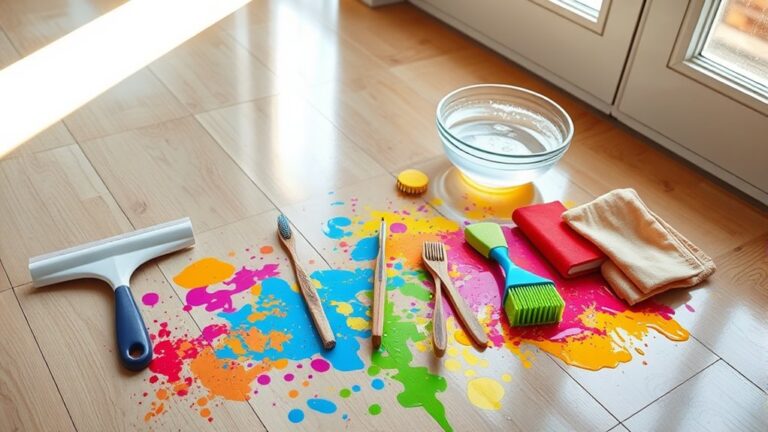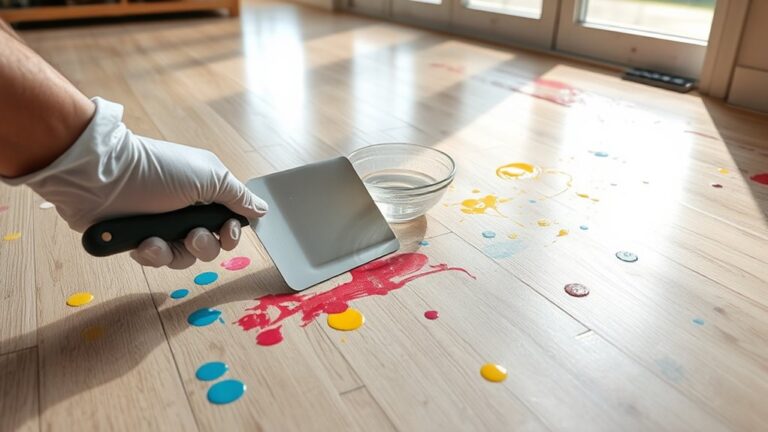Self-cleaning floors do work, using advanced technology to break down dirt, stains, and bacteria. Through mechanisms like photocatalysis and special coatings, these floors can maintain a cleaner, healthier environment in your home. They considerably reduce cleaning time and effort, helping you keep allergens and germs at bay. However, they aren't completely maintenance-free; regular dusting and spot cleaning remain necessary. While they offer several advantages, understanding their limitations is essential for managing expectations. If you're curious about the different types and how to make the most of them, there's plenty more to uncover!
What Are Self-Cleaning Floors?
Self-cleaning floors are increasingly becoming a popular choice for homeowners and businesses alike. These innovative surfaces are designed to minimize the need for traditional cleaning methods, offering a practical solution for maintaining hygiene and cleanliness. Self-cleaning floors utilize advanced technology that incorporates self-cleaning materials, which react with dirt, stains, and bacteria to break them down and eliminate them from the surface.
You might be wondering how these floors can be so effective. Thanks to recent technology advancements, self-cleaning materials can harness various mechanisms such as photocatalysis or hydrophilic properties. These features enable the vloer to repel dirt and grime, making it easier for any contaminants to wash away with minimal effort. Imagine walking into your home or office and feeling assured that your floors are taking care of themselves, contributing to a safer and healthier environment.
Moreover, self-cleaning floors can be particularly beneficial for spaces that require high cleanliness standards, such as hospitals or kitchens. With these surfaces, you won't have to worry as much about germs or allergens settling in, which is essential for ensuring the safety of your family or customers.
How Do They Work?
Many people are curious about how self-cleaning floors actually function. These innovative surfaces utilize a combination of mechanical processes and chemical reactions to keep your space looking fresh and clean. When you step on a self-cleaning floor, it can trigger a series of actions that help eliminate dirt and grime.
One common method involves a special coating that contains nanoparticles. These particles can break down dirt at a molecular level through chemical reactions. When exposed to light, they create a reaction that generates energy, allowing the floor to decompose organic matter, such as spills or stains, into harmless substances. This means you won't have to worry about stubborn stains lingering for too long.
In addition to chemical processes, mechanical actions also play an important role. Some self-cleaning floors have textures or patterns that help dislodge dirt and debris. For instance, when you walk across the surface, the friction can lift particles away, making it easier for the floor to maintain its cleanliness.
Safety is a top priority with these floors. Most self-cleaning technologies are designed to be non-toxic, ensuring that you and your family stay safe while enjoying the benefits of a cleaner environment. So, when you're considering self-cleaning floors, rest assured that they harness the power of both mechanical processes and chemical reactions to provide a practical solution for maintaining cleanliness in your home.
Types of Self-Cleaning Floors
There are several types of self-cleaning floors available, each employing unique technologies to keep your space spotless. You'll find options that utilize advanced materials like electrostatic surfaces and nanotechnology coatings, designed to repel dirt and bacteria effectively. Here's a quick look at some popular types:
| Type | Technology Used | Voordelen |
|---|---|---|
| Electrostatic Surfaces | Uses static electricity to repel dust and dirt | Reduces allergens, easy maintenance |
| Nanotechnology Coatings | Coating that breaks down organic matter upon exposure to light | Kills bacteria, self-sanitizing |
| Photocatalytic Floors | Uses UV light to activate a chemical reaction | Eliminates odors, eco-friendly |
Electrostatic surfaces work by creating a charge that attracts dust and dirt particles, preventing them from settling. This means you can enjoy cleaner air and a healthier environment. On the other hand, nanotechnology coatings are engineered at a microscopic level, allowing them to break down dirt and grime through chemical reactions, making cleaning effortless.
Photocatalytic floors take this a step further by utilizing UV light to enhance their self-cleaning properties. These floors not only keep your area clean but also contribute to a safer environment by eliminating harmful microorganisms.
Effectiveness of Self-Cleaning Floors
The effectiveness of self-cleaning floors can be quite impressive, especially when you consider the technology behind them. These floors often utilize advanced materials and coatings designed to repel dirt, bacteria, and other contaminants. When you walk on them, the self-cleaning mechanism activates, breaking down grime and allowing it to be easily wiped away or washed off.
To evaluate their performance, many manufacturers provide performance metrics that you can review. These metrics typically include stain resistance, antimicrobial properties, and ease of maintenance. Such data can help you determine how well a self-cleaning floor will hold up in your specific environment, whether it's a busy household or a commercial space.
User testimonials also offer valuable insights into real-world effectiveness. Many users rave about how much easier cleaning becomes with these floors. They often report reduced time spent on maintenance and the peace of mind that comes from having a more hygienic living space. Some even mention how the floors maintain their appearance over time, which can be a considerable factor in your decision-making process.
It's important to remember that while self-cleaning floors can considerably reduce the amount of manual cleaning needed, they aren't entirely maintenance-free. Understanding their effectiveness through performance metrics and user feedback can help you make an informed choice that aligns with your safety and cleanliness goals.
Advantages of Self-Cleaning Technology
Self-cleaning technology offers numerous advantages that can make a significant difference in your daily routine. One of the most appealing aspects is the time-saving benefits it provides. Imagine not having to spend hours scrubbing floors or worrying about dirt and grime piling up. With self-cleaning floors, you can reclaim that time for more enjoyable activities, whether it's spending time with family, pursuing hobbies, or simply relaxing after a long day.
Another key advantage is the eco-friendly options available in self-cleaning technology. Many self-cleaning systems utilize environmentally safe materials and processes that reduce the need for harsh chemical cleaners. This not only benefits the planet but also creates a safer home environment for you and your loved ones. By minimizing chemical exposure, you're taking a step toward a healthier living space, particularly important for families with children or pets.
Moreover, self-cleaning floors can help maintain a higher level of hygiene. These advanced systems often utilize features like antimicrobial coatings, which can inhibit the growth of bacteria and allergens. This means you can enjoy peace of mind knowing your floors are not just clean, but also healthier.
Limitations and Drawbacks
While self-cleaning floors offer many benefits, they also come with some limitations and drawbacks that you should consider. One of the main concerns is the product lifespan. Self-cleaning technology often relies on specific features, such as coatings or cleaning agents, which may wear out or lose effectiveness over time. This means you might need to replace the floors sooner than you'd expect, leading to additional costs.
User expectations can also pose a challenge. Many people assume that self-cleaning floors will eliminate all manual cleaning. However, while these floors reduce the frequency and intensity of cleaning, they don't completely eliminate the need for maintenance. Stubborn stains or spills still require your attention. If you're not prepared for this reality, you might find yourself disappointed.
Additionally, the technology can sometimes be sensitive to certain cleaning products or environmental factors, which could limit your choices. For instance, some self-cleaning surfaces may react poorly to abrasive cleaners, compromising their functionality and potentially leading to damage.
Onderhoudsvereisten
To keep your self-cleaning floors in top shape, you'll need to stay on top of regular maintenance tasks. This includes not just periodic inspections but also using the right cleaning solutions to guarantee peak performance. Let's explore what you need to do to maintain their effectiveness and longevity.
Regular Maintenance Tasks
Maintaining a self-cleaning floor isn't just a set-it-and-forget-it affair; regular upkeep is essential to guarantee peak performance. While these floors are designed to reduce your cleaning workload, they still require your attention to function effectively over time.
To help you stay on track, here's a straightforward table outlining essential maintenance tasks and their recommended cleaning frequency:
| Maintenance Task | Cleaning Frequency |
|---|---|
| Verwijderen van stof en vuil | Dagelijks |
| Vlekken verwijderen | Indien nodig |
| Deep cleaning (mop/steam) | Wekelijks |
| Inspecteer op schade | Maandelijks |
| Check and refill cleaning solution | Elke 3 maanden |
Aanbevelingen voor reinigingsoplossingen
Keeping your self-cleaning floor in top shape means paying attention to the cleaning solutions you use. Not all products are safe or effective for these advanced surfaces, so it's crucial to choose wisely.
When selecting cleaning solutions, look for pH-neutral products specifically designed for self-cleaning floors. Avoid harsh chemicals, as they can damage the floor's protective layer and reduce its effectiveness. Brands like Bona or Zep often come highly recommended for their gentle yet efficient formulas.
You might also consider eco-friendly options, like vinegar diluted with water, which can clean effectively without introducing harmful substances into your home. However, always check your floor's warranty and manufacturer recommendations before using any homemade solutions.
For ongoing maintenance, it's a good idea to regularly use these recommended products to keep the floor's self-cleaning properties intact. By being mindful of your choices, you can guarantee your self-cleaning floor performs at its best while keeping your home safe and healthy. Remember, your cleaning solution choices matter, so stick to trusted product recommendations for the best results.
Kostenvergelijking
When considering self-cleaning floors, it's essential to weigh the costs against the benefits. The initial installation costs of self-cleaning flooring can be higher than traditional options. Depending on your choice—like smart tiles or advanced coatings—you might spend a bit more upfront. However, these costs shouldn't deter you from considering the long-term savings they can offer.
First off, think about the time you save. With self-cleaning floors, you won't need to scrub or mop as often, which can free up valuable time in your busy schedule. This can translate to less money spent on cleaning supplies and services over the years. Additionally, many self-cleaning options are designed to be more durable and resistant to stains, which could mean fewer repairs or replacements in the long run.
Moreover, self-cleaning floors can contribute to a healthier home environment. By reducing mold, bacteria, and allergens, they may help you save on medical bills associated with allergies or respiratory issues. When you factor in these potential health benefits, the initial installation costs seem more justified.
Customer Experiences and Reviews
Many homeowners who've installed self-cleaning floors rave about the convenience and ease of maintenance they provide. Their user experiences often exceed initial cleaning expectations, leading to a newfound appreciation for their living spaces. Many report that these innovative floors save time and effort, allowing them to focus on more important tasks.
Here's a glimpse into what satisfied customers typically mention:
- Reduced Cleaning Time: Many users find that they spend considerably less time cleaning compared to traditional flooring options.
- Verbeterde veiligheid: These floors often boast features that minimize slips and falls, promoting a safer environment for families, especially those with children or elderly members.
- Odor Control: Self-cleaning technology can help eliminate unpleasant smells, improving indoor air quality and creating a fresher living space.
- Duurzaamheid: Homeowners appreciate the longevity and resilience of these floors, which often withstand spills and heavy foot traffic.
However, some reviews highlight that while self-cleaning floors are beneficial, they're not entirely maintenance-free. Users emphasize the importance of routine checks to guarantee peak performance. Overall, the consensus is clear: self-cleaning floors can greatly ease your cleaning routine, enhancing your home's safety and cleanliness. If you're considering the switch, you might just find that the investment pays off in the long run, giving you more time to enjoy your home and less time worrying about its upkeep.
Veelgestelde vragen
Can Self-Cleaning Floors Eliminate Pet Odors Effectively?
Imagine walking into a home that smells as fresh as a spring morning. You might wonder if self-cleaning floors can tackle pet odors effectively. While they can aid in odor absorption, they're not a complete solution. Pet dander can linger, so regular cleaning is still essential. Think of self-cleaning floors as a helpful partner in your fight against smells, but don't rely solely on them for a truly fresh environment.
Are Self-Cleaning Floors Safe for Children and Pets?
When considering if self-cleaning floors are safe for children and pets, it's important to assess child safety and pet health. Generally, these floors use non-toxic materials and automated cleaning methods, which can reduce harmful chemicals. However, you should guarantee your cleaning system doesn't leave residues that could affect your little ones or furry friends. Regularly check for any signs of wear or malfunction to maintain a safe environment for your family.
Do Self-Cleaning Floors Require Specialized Cleaning Products?
You might think self-cleaning floors are hassle-free, but do they really need special cleaning products? The truth is, while advanced cleaning technology can reduce maintenance requirements, you'll often still need conventional products for tough stains. Most self-cleaning surfaces can handle regular cleaners, but it's wise to check the manufacturer's recommendations. By doing so, you guarantee a safe environment for your family, while still enjoying the benefits of innovative flooring solutions.
How Long Do Self-Cleaning Floors Typically Last?
When considering how long self-cleaning floors typically last, you'll want to keep maintenance frequency and durability factors in mind. Generally, these floors can last anywhere from 10 to 25 years, depending on the materials used and how well you care for them. Regular maintenance and avoiding harsh chemicals can extend their lifespan. Always prioritize safety by choosing products that are compatible with your floor type to guarantee long-lasting durability without compromising your home environment.
Can Self-Cleaning Floors Be Installed in Outdoor Areas?
Imagine strolling on a floor that cleans itself while you enjoy the great outdoors. While self-cleaning floors can be installed in outdoor areas, there are installation challenges to contemplate, like ensuring proper drainage and material durability against weather conditions. Outdoor durability is key; not all self-cleaning technologies thrive under UV exposure or temperature fluctuations. Always prioritize safety and choose materials specifically designed for outdoor use to prevent slips and damage.




